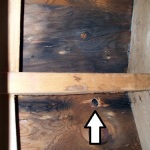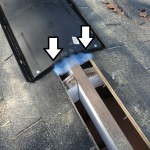A typical call goes something like this. Good morning mold person. I had a home inspection and they found mold in my attic and recommended removing the mold and improving the attic ventilation system. I had a contractor in to install ridge venting now I need the mold removed.
In my head I am thinking ” mold removal before ventilation” not the other way around. I say it over and over again. The process of mold removal and the application of sealant can clog new ridge vents. I arrived at the house and this is what I found. The contractor drilled a 3/4″ hole through the ridge every 16″, misinterpreting the code of a 3/4″ minimum continuous cut. On top of that he installed a rolled ridge vent that was collapsed and performing no function.
The 3/4″ cut is too small for the amounts of insulation we have in our homes. My recommendation is to double that to 1 1/2″. Also, I have to remove the new ridge vent and caps, properly cut open the ridge and install a new performing ridge vent and caps.
In the image I have here you can see that the ridge cut should be equal to the vented opening of the ridge vent. The blue mesh filter should span side to side.
The other low bid, great deal contractor disappeared after the job and the homeowner had to pay the bill for the new work. I am not completely blaming the contractor. The homeowner is probably equally at fault. I bet there was at least one bid, probably the highest, who told the homeowner exactly what needed to be done.
Also remember that the general contractor, roofing contractor or home improvement contractor all are not ventilation or mold experts. Hire only qualified and insured (liability and workman’s comp insurance) certified mold remediation and ventilation contractors.
In order: Mold remediation first, ventilation second, air sealing third, insulation last.


